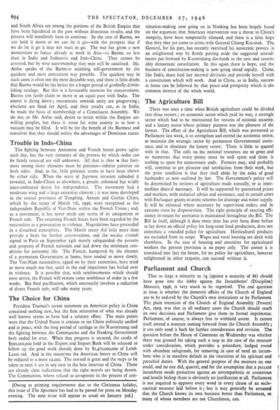Trouble in Indo-China
The fighting between Annamese and French forces grows uglier each day, but the very elements of the process by which order can be firmly restored are still unknown. All that is clear is that fore- most among those elements must be patience—infinite patience on both sides. And, so far, little patience seems to have been shown by either side. When the wave of Japanese invasion subsided it revealed, in Indo-China as elsewhere, a greatly enhanced but wildly unco-ordinated desire for independence. The movement had a moderate wing and a large extremist element ; it was most developed in the coastal provinces of Tongking, Annam and Cochin China, which by the treaty of March 7th, 1946, were recognised as the independent Republic of Viet-Nam within the French Union ; and, as a movement, it has never made any secret of its antagonism to French rule. The returning French forces have been regarded by the nationalists as a provocation to violence. Negotiations have proceeded in a disturbed atmosphere. The March treaty did little more than provide a basis for further conversations, and the modus vivendi signed in Paris on September 14th merely safeguarded the persons and property of French nationals and laid down the minimum con-
ditions for economic life. The French, hampered by the absence of a permanent Government at home, have tended to move slowly.
The Viet-Nam nationalists, egged on by their extremists, have tried to move much too fast, until in the end impatience has boiled over in violence. It is possible that, with reinforcements which should soon arrive, the French will restore some semblance of order in a few weeks. But final pacification, which necessarily involves a reduction of direct French rule, will take many years.






























 Previous page
Previous page